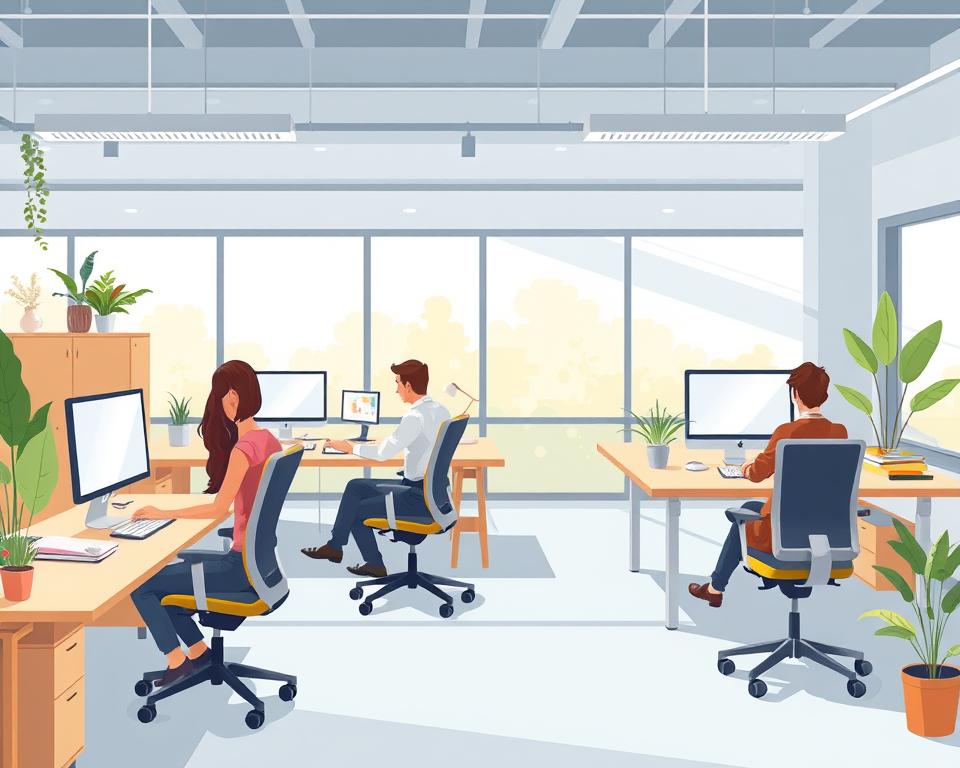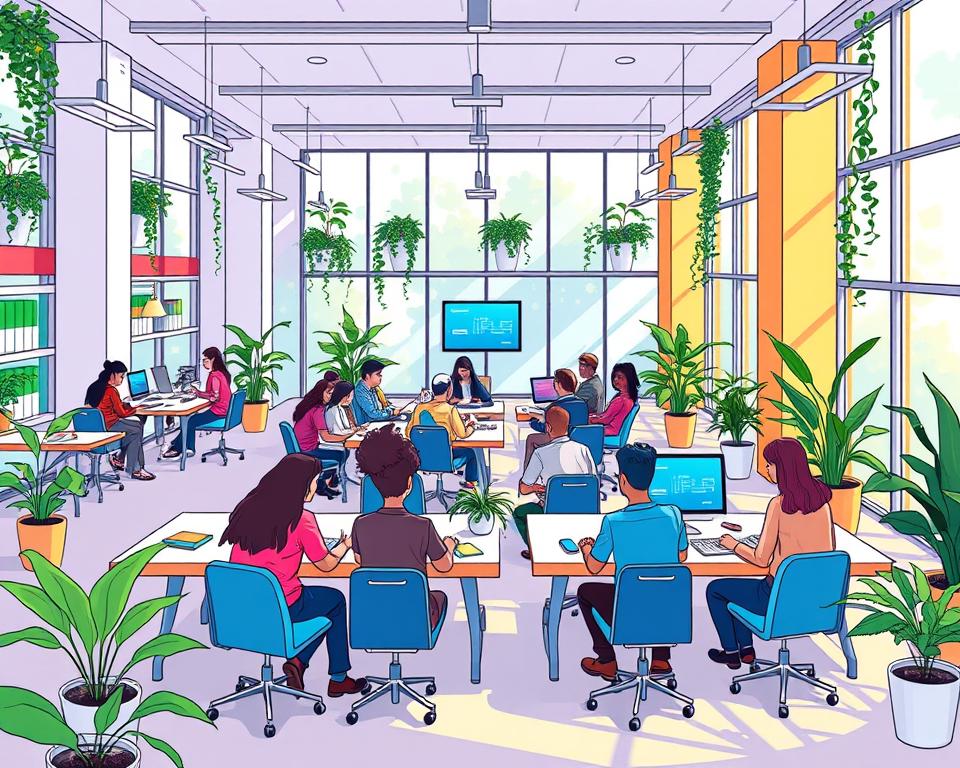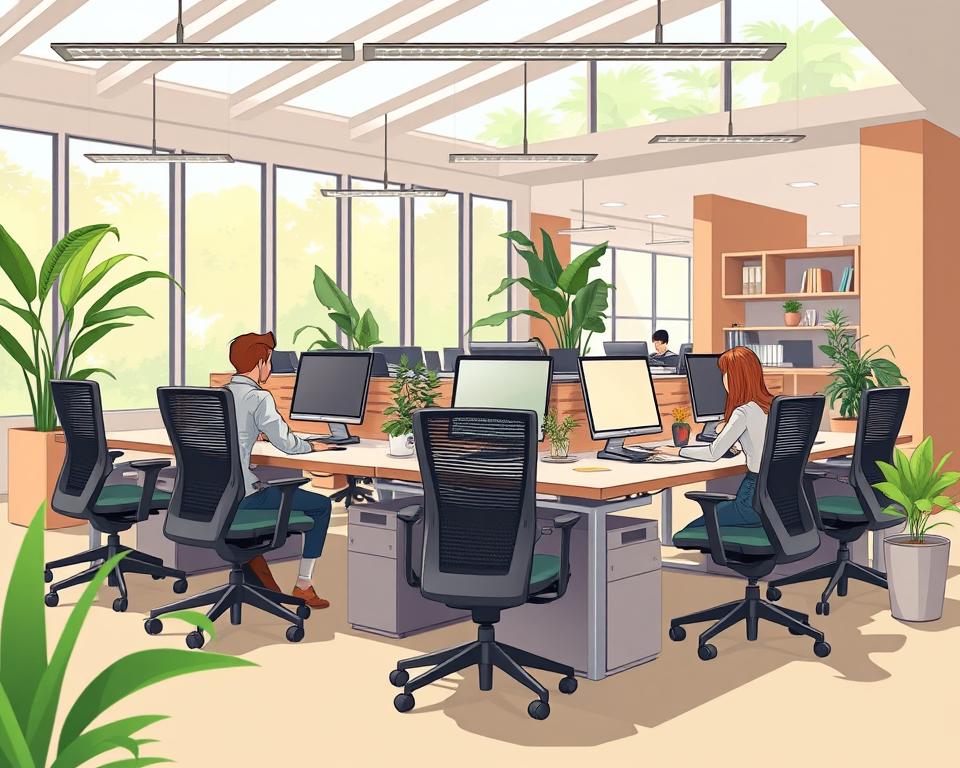Across Australia, ‘workplace’ is no longer just a location; it’s a dynamic concept that continuously evolves, reflecting our values, technologies, and insights into the human psyche. It begs the question – how often do we review our workplace design to ensure it keeps pace with innovation, inclusivity, and the well-being of every individual within the space?
At Spire Safety Consultants, we recognise the profound link between environment and ethos. Projects such as those we have undertaken foe numerous businesses stand testament to the forward-thinking approaches that place employee well-being at the core of workplace design enhancement. But it’s not just about the aesthetic appeal; legal obligations like the Disability Discrimination Act 1992 and Disability (Access to Premises – Buildings) Standards 2010 require us to reassess and create accessible, sustainable office designs.
With productivity in Australian offices heavily hinged on how environments interact with mental and physical health, the importance of ergonomic assessments and accessibility adaptations cannot be overstated. They’re not just satisfying a checklist; they contribute in real terms to job satisfaction, efficiency, and the minimisation of work-related health issues prevalent across the country.
We understand that the very fabric of Australian business is changing. The workplace must support diverse workstyles and offer the flexibility needed to navigate the complexities of today’s professional landscapes. Adapting to this change means creating spaces that foster both community and individual thought – a balance as crucial as it is delicate. And with this challenge comes the opportunity for exciting reinvention. The conversation on the role of regular reviews of workplace design is hot, fuelled by the need for spaces that deliver on productivity, employee well-being, and sustainable office design.
After all, what is a workplace if not a reflection of its people? By prioritising regular reviews and constantly adapting to emergent needs, we have the chance to reimagine Australian offices not just as places of work, but as catalysts for innovation, satisfaction, and holistic success.
The Importance of Regular Reviews of Workplace Design for Employee Well-being
As organizations across Australia strive to enhance employee satisfaction and productivity, the focus has increasingly shifted towards the importance of work design and flexibility. Acknowledging the direct link between well-designed work environments and the mental health at work, our approach integrates robust strategies endorsed by the Australian Fair Work Ombudsman to promote a healthier, more productive workplace.
Research indicates that environments which reflect employee needs significantly contribute to job satisfaction and efficiency. The influence of physical space on well-being cannot be understated, with studies showing that excessive noise and the lack of personal space can hinder performance and mental health.
Link Between Workplace Design and Employee Mental Health
Mental health is profoundly impacted by workplace aesthetics and functionality. Access to natural light and views, quiet work areas, and ergonomic setups prove critical in alleviating stress. Encouraging regular reviews of workplace design is vital to ensure these elements align with modern standards for a mentally healthy workplace.
Impact of Design on Productivity and Satisfaction
Well-thought-out spaces that cater to the diverse needs of a multigenerational workforce can boost overall productivity. Flexibility in work location and hours, as supported by the Australian Fair Work Ombudsman, offers employees the control to design their workday optimally, leading to increased job satisfaction and reduced turnover.
- Open-plan vs. Quiet Spaces: While open-plan designs cater to collaboration, they can also contribute to distractions. Balancing these with designated quiet areas can help mitigate the downsides.
- Adaptive Furniture and Technology: Modular furniture and advanced technological infrastructures must be incorporated to ensure that workspaces can evolve with changing employee needs.
- Inclusive Design: A focus on creating spaces that support individuals regardless of their background or abilities can foster a more inclusive and supportive working environment.
By prioritizing work design and offering more flexibility, we not only support the immediate needs of our employees but also contribute to a more resilient and successful organizational culture.
How Ergonomic Assessments Contribute to Productivity Optimisation
In the dynamic landscape of Australian workplace design, ergonomic assessments play a pivotal role in not just safeguarding employee health but also in driving productivity optimization. These assessments, when carried out meticulously, can halve the incidents of work-related injuries, demonstrating their critical importance in modern office setups.

Implementing ergonomic practices is more than a health measure; it’s a strategic investment. Companies that have embraced thorough and regular reviews of their workspace ergonomics report a 20% boost in employee productivity. Furthermore, this proactive approach to workplace design reduces absenteeism by up to 30%, thanks to the decline in work-related ailments.
- Financial Benefits: Regular ergonomic assessments have been shown to cut medical costs related to musculoskeletal disorders by up to 25%. This financial saving is crucial for businesses looking to enhance their bottom line while maintaining a healthy workforce.
- Enhanced Job Satisfaction: Surveys reveal a 15% increase in job satisfaction rates following the implementation of ergonomics interventions. This is likely due to employees feeling more comfortable and less fatigued during work hours.
- Quality of Work: There’s a notable improvement in the quality of work produced, with a 10% uplift post ergonomic enhancements. This is indicative of a more engaged, healthier workforce.
- Cultural Shift: A safety-first culture in the workplace is invaluable. Regular assessments foster an environment where safety is prioritized, culminating in a 15% reduction in workplace accidents.
Ergonomic assessments are not a one-time task but an ongoing commitment. Regular reviews and updates ensure that the workplace evolves with changing employee needs and the latest in ergonomic research. In Melbourne, it’s recommended that businesses conduct these assessments annually or whenever significant changes occur, be it in physical office settings or in staffing.
Adopting a proactive approach to ergonomic assessments not only enhances productivity optimization but also endorses a caring and conscientious workplace culture. By prioritizing the comfort and safety of employees, businesses can achieve remarkable improvements in efficiency, satisfaction, and overall business outcomes.
Incorporating Collaborative Spaces to Enhance Team Dynamics
In the ever-evolving landscape of Australian corporate culture, the adaptation towards hybrid working models has necessitated a rethinking of workspace design. Nurturing environments that foster both collaborative spaces and private work areas are imperative to cater to the diverse needs of modern workforces.

Understanding the shift towards these hybrid working models helps us appreciate why workspace flexibility is not just a trend, but a strategic imperative. A staggering 78% of employees affirm that a collaborative environment significantly spikes their productivity. Conversely, private work areas remain crucial, with around 70% of employees stating that a lack of such spaces can negatively impact focus due to the noise levels commonly found in open office settings.
The Shift to Hybrid Working Models in Australia
The move to hybrid models across Australian industries reflects a broader global shift in employment patterns. These models blend in-office and remote work preferences, addressing issues like commutation and work-life balance, and necessitating the inclusion of both collaborative and private work areas to support these varied work styles.
Creating Balance Between Private and Communal Work Areas
To strike the perfect balance between collaborative and private work areas, we’ve found that engaging employees in the design process leads to more liveable and workable solutions. Spaces designed for collaboration commonly include diverse settings such as open-plan areas, shared workbenches, and clusters that foster impromptu interactions and group activities. For private tasks that require deep concentration, providing sound-proof zones, privacy booths, and quiet rooms are essential.
Data supports that 72% of employees believe workspace flexibility, which allows choosing between different working environments based on the task at hand, significantly enhances productivity. Our aim is always to develop workspaces that not only mitigate the challenges but maximize the advantages of hybrid working models.
Ultimately, integrating collaborative spaces into workplace design isn’t just about placing desks together or adding more meeting rooms. It encompasses a comprehensive strategy that involves flexible furniture, technology integration, and innovative design elements such as biophilic features, all aimed at fostering a culture of creativity and collaboration.
At the core, our focus is on tailoring environments that uplift team dynamics while respecting individual needs for privacy, reflecting a culture where both the company and its employees thrive in unison.
Adaptable Layouts: Responding to Changing Business Needs
In response to the ever-evolving business landscape in Australia, we understand how pivotal adaptable layouts are in addressing the diverse workstyles and enhancing workspace flexibility. These dynamic layouts go beyond the aesthetics; they serve the functional need to swiftly adapt to team expansions or contractions and project shifts—ensuring that the workspace remains an enabler of productivity and well-being. According to recent statistics, 74% of Australian businesses have acknowledged that well-designed workspaces are a significant productivity booster.
Catering for Diverse Workstyles and Flexibility
Providing ergonomic and tailored environments addresses unique employee needs, which is something 58% of Australian companies affirm improves their workforce’s well-being. A staggering 80% have observed how customised office layouts lead to better space utilisation, while 72% have noted the necessity of agile office designs to meet the Australian workforce’s demand for flexibility. With up to 15% savings in office costs through these tailored layouts, it’s no surprise that the corporate culture within Australian companies is strengthening, as 68% of them report.
Case Studies of Adaptive Reuse in Australia
Furthermore, adaptive reuse stands out as a forward-thinking practice in Australia, merging the conservation of architectural heritage with contemporary office needs. By reimagining existing structures for new uses, Australian businesses are curbing construction waste and creating distinctive, inspiring work environments. This symbiotic relationship between the old and the new not only preserves our cultural legacy but also caters to the 85% of employees looking for modern setups with flexible spaces and amenities. With 63% of businesses pioneering hybrid office layouts to accommodate various work styles, it is evident that regular reviews of workplace design are instrumental in maintaining a harmonious balance between employee satisfaction and strategic business needs.
FAQ
Q: How often should workplace design be reviewed in Australia?
A: Regular reviews of workplace design should ideally be conducted annually or when significant changes in work practices or team dynamics occur. This ensures that the workspaces remain suitable for productivity in Australian offices and align with employee well-being and sustainable office design trends.
Q: What roles does workplace design play in employee mental health?
A: Workplace design is closely linked to employee mental health, with elements such as lighting, ergonomics, and noise levels significantly affecting stress levels and well-being. The Australian Fair Work Ombudsman recognises work design and flexibility as vital factors in supporting mental health at work.
Q: Can improvements in workplace design lead to higher productivity and job satisfaction?
A: Absolutely, when workplaces are designed with employee needs in mind, productivity and job satisfaction can increase. Adequate lighting, comfortable workstations, and consideration for visual and acoustic privacy all contribute to an environment that enhances focus and satisfaction.
Q: What are ergonomic assessments, and how do they benefit a workplace?
A: Ergonomic assessments involve analysing the work environment to ensure that it fits the employee’s needs, helping prevent injuries and strain. Regular reviews and updates based on these assessments can lead to productivity optimisation and a healthy, engaged workforce.
Q: How do collaborative spaces contribute to the dynamics of a team?
A: Collaborative spaces are designed to encourage teamwork and spontaneous interactions, helping build a strong, dynamic team culture. Such spaces are a critical component of workplace design enhancement, especially within hybrid working models in Australia, offering both communal and private work areas.
Q: What is the significance of workspace flexibility in modern office design?
A: Workspace flexibility caters to the varying preferences of employees, particularly in hybrid working models. It offers employees the choice to work in environments that suit their needs on any given day, balancing concentrated individual tasks and group collaboration.
Q: Why are adaptable layouts important in the workplace?
A: Adaptable layouts provide the necessary flexibility to adjust spaces for different tasks, team sizes, and changes in business priorities. By enabling quick reconfiguration, these layouts support diverse workstyles and can contribute to an engaged and adaptable workforce.
Q: What benefits does adaptive reuse offer for office spaces?
A: Adaptive reuse in Australia offers several benefits, including the preservation of cultural heritage, reduced environmental impact, and the creation of unique and inspiring workplaces. These reimagined spaces can improve creativity and offer a sense of belonging and identity within the office.

